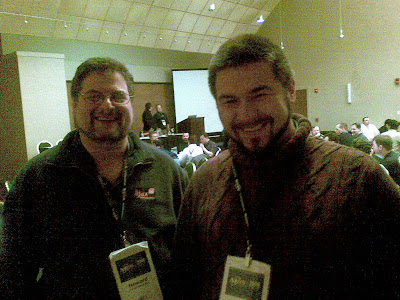
One of the cool things that keeps drawing me towards Tapestry is the goal to make it really easy and intuitive to work with. One of the goals that I remember hearing for Tapestry 5 was to make it that easy, that it would compete more w/ Grails & Rails and not so much w/ traditional Java Web app frameworks (e.g. Struts, Struts2, etc)
However, when I first took a look at Tapestry 5, I was a little disappointed by the six line Maven command that one had to type in when starting a new project (e.g. see http://tapestry.apache.org/tapestry5/tutorial1/first.html):
mvn archetype:create
-DarchetypeGroupId=org.apache.tapestry
-DarchetypeArtifactId=quickstart
-DgroupId=org.apache.tapestry
-DartifactId=tutorial1
-DpackageName=org.apache.tapestry.tutorial
Compare that with Grails:
grails create-app
Welcome to Grails 1.0 - http://grails.org/
Licensed under Apache Standard License 2.0
Grails home is set to: /usr/local/java/grails
Application name not specified. Please enter:
FooApp
---------------
[propertyfile] Updating property file: /home/polrtex/temp/FooApp/application.properties
Created Grails Application at /home/polrtex/temp/FooApp
It is true that one doesn't create an application all that often, and copy-and-pasting
these initial 5-6 lines would not be that big of a deal. However, for a newcomer, the Tapestry 5 experience has to be really smooth and starting a new app should be a breeze.
So, you would say, what does this have to do with NetBeans ?
Here it comes. As usual, NetBeans rocks everyone's socks, by lowering the entry barrier into starting an application. Here are the first steps (equivalent to the first two pages of the Tapestry tutorial : http://tapestry.apache.org/tapestry5/tutorial1/env.html). Here is what you need to do:
( Assuming that you already have a good install of NetBeans 6.1).
- Install the NetBeans Maven plugin by going into Tools -> Plugins . Type "maven" in the upper-left corner search box and install the plugin. The result should look something like this:

- Create a new Maven project

- Expand the "Archetypes from remote Maven repositories" and scroll down to find the Tapestry5 quickstart archetype . You might want to pay close attention to the description and select the latest archetypes (in my case, for 5.0.11)

- Now that you have the nice wizard, fill out the configuration attributes to specify the group id, the location of the project, the name of the project, etc.

- When you hit Finish, Maven will start downloading all the dependencies and setting up your project.
- Your new and shiny project is ready to go. Go into the project Properties and select your desired server to deploy to:

- Run the project from the project context menu and you're up and running !!!!

One very cool option that makes the Tapestry 5 setup almost identical to the Grails setup is the ability to run the application in Jetty by going to the command line and running:
mvn jetty:run
The upside of doing this is that after you run it, there is no deployment step. Tapestry supports reloading of the page templates as well as the page classes. As a result, whenever you make a change to a page, you can save it, refresh the browser and see the changes . Similarly, when you make a change to a class, compile it and the changes are immediately visible to the application. Such a setup really cuts down on waiting for the app to deploy.
So now, looking back a little bit, this setup is indeed very competitive w/ the Grails setup. In Grails, you would download the Grails distribution, and then would run the "grails create-app" command to create the new project. Grails would then prompt you for some properties (e.g. project name) and you're done. For Tapestry, it's quite similar; however, instead of downloading the Tapestry distribution, you would simply download Maven2 (or in the case of NetBeans, you would install the NetBeans plugin). Even better for Tapestry, if you already have Maven install, then starting a new app becomes a zero cost operation : you just specify the command line args (or better yet, use NetBeans to create the new app) and you're on your way, all dependencies already in place.
So, so far it's a tie between Grails and Tapestry. Grals vs Tapestry = 1:1
Enjoy your shiny and new Tapestry 5 app in NetBeans !!!